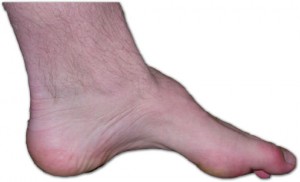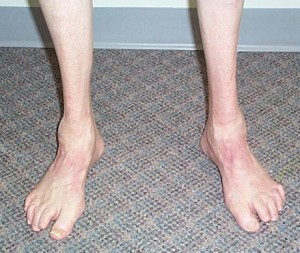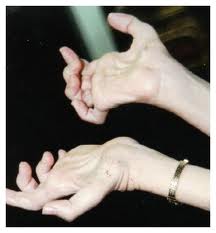Charcot marie tooth disease is a dreaded disorder that annually affects around 150,000 people in the U.S. Read on to know more about the condition, including its causes, symptoms, diagnosis and treatment.
What Is Charcot marie tooth disease?
Page Contents
- 1 What Is Charcot marie tooth disease?
- 2 Charcot marie tooth disease Names
- 3 Charcot marie tooth disease Types
- 4 Charcot marie tooth disease Symptoms
- 5 Charcot marie tooth disease Causes
- 6 Charcot marie tooth disease Diagnosis
- 7 Charcot marie tooth disease and Genetic Testing
- 8 Charcot marie tooth disease and Nerve Biopsy
- 9 Charcot marie tooth disease Treatment
- 10 Charcot marie tooth disease Prognosis
- 11 Charcot marie tooth disease Complications
- 12 Charcot marie tooth disease Risk Factors
- 13 Charcot marie tooth disease Prevention
- 14 Charcot marie tooth disease Management
- 15 Charcot marie tooth disease Pictures
It refers to a cluster of disorders that run down generations. It affects the peripheral nerves, or the nerves located outside the spine and the brain. This is essentially a neurological condition that progresses to the body muscles from the nervous system.

Picture 1 – Charcot marie tooth disease
A hereditary disease, it was discovered in the year 1886 by three doctors. They were Jean-Martin Charcot, Pierre Marie, and Howard Henry Tooth. The name of the disease actually makes a reference to the names of its discoverers.
Charcot marie tooth disease Names
Charcot marie tooth disease, abbreviated as CMT, is known by different names like:
- Charcot-Marie-Tooth neuropathy
- Progressive neuropathic (peroneal) muscular atrophy
- Hereditary peroneal nerve dysfunction
- Hereditary motor
- Sensory neuropathy (HMSN)
- Morbus Charcot-Marie-Tooth
- Hereditary sensorimotor neuropathy
Charcot marie tooth disease Types
The condition is classified by medical researchers into various types, such as:
CMT Type 1
It accounts for around one-third of all cases of CMT. It is the most common form of CMT that is autosomal dominant in nature. It results in demyelination (loss of myelin cover of some nerve fibers making them function in a defective manner), which may be diagnosed by evaluating nerve conduction velocities. Impulse conduction is found to be retarded along the nerve segment in regions of focal demyelination. This CMT type mainly causes anatomic changes that directly impact the myelin sheath. Secondary axonal changes are also found to occur.
CMT Type 2
It is found to affect about 20-40% of all CMT sufferers. The type-2 form mainly affects the axon and is autosomal dominant in nature. The average velocity of nerve conduction is somewhat below usual though generally higher than 38m/s. CMT2 tends to affect the upper extremities less and the lower extremities more.
Type 2 of CMT is often a clinically less acute disorder than Type 1.
CMT Type 3
It affects very less number of CMT patients and is autosomal recessive in nature.
CMT Type 4
Type 4, like Type 3, affects very few patients of CMT. Like the other 3 types of CMT, it is autosomal recessive. This means, a child must inherit a copy of the defective gene causing the disease for both parents. It is only through inheriting two recessive mutant genes that a person can become a victim of this condition.
CMT X-Linked
It afflicts approximately 10-20% patients of CMT. According to a medical study published in 1997, this CMT type is associated with a connexin 32 gene mutation. It is a X-linked dominant condition and not autosomal recessive like the other 4 forms of CMT.
Charcot marie tooth disease Symptoms
The initial symptoms of Charcot Marie Tooth Syndrome are generally noticed in the feet. Patients usually suffer from a high arching of the foot. Some patients with CMT may also suffer from a very flat feet. As the disorder advances, hammer toes and other problems of the feet may be noticed. Motor nerves, or the nerves that stimulate movement, are most seriously affected by CMT.
This is a degenerative condition and gradually weakens the muscles in the limbs of patients. Sufferers typically begin to experience problems in walking and moving about in general. The sense of balance tends to get disorientated in patients and he or she begins to experience difficulties while running. The muscles in the hands begin to weaken and patients begin to experience difficulties in carrying out simple tasks, such as opening a door.
With progressive loss of nerve functions in the limbs, patients may also suffer from loss of sensory nerve perception in the extremities. They may be unable to experience basic sensations such as scalding or burning in the limbs. Lumps, ulcers or blisters may also develop over the hands and feet of sufferers.
The symptoms of this condition usually arise between mid-childhood and early stages of adulthood. These primarily include discomforts like:
- Foot drop (Lack of ability to lifting the foot at the ankle)
- Curled toes (hammertoes)
- Very high arch of feet
- Skinny calves, occurring due to loss of muscle in the lower leg
- “Slapping” gait, characterized by feet hitting the floor firmly while walking
- Numbness or lack of sensation in the foot or leg
- Weakness in the hips, legs, ankles or feet
- Reduced ability to run
- Frequent stumbling or falling
The difficulties are initially experienced in the legs. With the progression of the disease, they may not be restricted to the lower areas and even affect the upper regions such as the thighs, arms and hands. A claw-like hand is one of the main symptoms in patients in later stages of CMT. Usually, no painful symptoms arise from this syndrome.
Charcot marie tooth disease Causes
Charcot-Marie-Tooth Syndrome is a group of associated disorders, all of which are caused by inherited genetic mutations. The mutations are noticed in those genes that are involved with the structure and function of the nerves serving the various extremities of the body, such as the arms, hands, legs and feet. Defects in at least 40 genes may be responsible for the development of various forms of this condition.
In some patients, the genetic mutations cause damage to the nerve itself. Other mutations damage or even destroy the protective coating, known as the myelin sheath, which surrounds the nerve. In all cases, extremities feebly send nerve impulses to the brain.
Patients of CMT often tend to trip and fall. This happens due to inability of the feet muscles to receive brain signals that tell them to contract. Even in case of an acute pain in the feet, the brain may not be able to receive messages. Patients may suffer from an infectious blister on their toe without actually being aware of it.
CMT is one of the most common nerve-related conditions that pass down through families. Patients may inherit the mutated gene causing the disease in either an autosomal recessive or dominant manner.
Charcot marie tooth disease Diagnosis
Diagnosis of this condition is generally done by a neurologist. If patients are suspected to be suffering from CMT symptoms, tests need to be conducted for its detection. A physical examination and diagnostic tests are needed to confirm presence of the disease. Physical exam may detect abnormalities like:
- Difficulty in lifting the foot up
- Stretching the toe out
- Loss of stretch reflexes in both legs
- Atrophy (shrinking of muscles) and lack of muscle control in the foot or leg
- Thickened nerve clumps beneath the skin of the legs
In CMT sufferers, nerve conduction tests are frequently carried out to distinguish between various types of the disorder. Nerve conduction studies evaluate the speed as well as the intensity of the electrical impulses that are transmitted through the nerves. The test involves placing electrodes on the skin and stimulating the nerve with small electric shocks. Weakened or slow responses may indicate the presence of a nervous condition such as Charcot-Marie-Tooth disease.
Doctors may also recommend other tests, which can aid in knowing about the cause and the severity of nerve damage in patients. These may involve electrodiagnostic tests, such as Electromyography (EMG). EMG involves inserting a thin needle electrode through the skin and into the muscle which is to be tested. Electrical activity is recorded as patients relax and gently tighten the muscle. Doctors are often able to determine how much the disease has spread by testing various muscles.
Charcot marie tooth disease and Genetic Testing
Genetic testing, as the name indicates, is used to detect the most common genetic flaws that cause Charcot marie tooth disease. It is done by an analysis of a sample of blood of the patient. Genetic testing is available for most variations of CMT and may be carried out to diagnose genetic causes of the disorder. Genetic tests provide CMT patients with vital information about the disease that can help them for family planning.
Charcot marie tooth disease and Nerve Biopsy
Doctors often use a nerve or muscle biopsy to confirm the diagnosis of CMT. Nerve biopsy simply indicates a laboratory examination of a nerve sample of a patient. In this procedure, a small cut is made on the calf of the patient’s leg. A minute sample of peripheral nerve is taken out of that incision. Laboratory analysis of the nerve helps differentiate Charcot Marie Tooth Syndrome fr,om other nerve disorders.
Charcot marie tooth disease Treatment
There is no known cure for this condition. However, certain treatment measures may help manage CMT symptoms in a better way. These include:
Surgery
Orthopedic foot surgery can help correct severe foot deformities, reduce pain and improve the ability to walk. However, it cannot improve loss of sensation or weakness.
Therapy
Occupational and Physical therapy can increase muscle strength and help limbs function independently. Stretching techniques and low-impact exercises can delay nerve deterioration and reduce muscle fatigue.
Medications
Some CMT patients may not experience pain but suffer from nerve damage or muscle cramps. Prescription medicines may be useful in controlling such difficulties.
Orthopedic devices
Orthopedic devices, such as high-top shoes, splints, braces and other equipments can provide stability, improve gait, help move about normally and prevent injury.
Charcot marie tooth disease Prognosis
Charcot-Marie-Tooth disease slowly gets worse. Some parts of the body may become numb, and pain can range from mild to severe. Eventually the disease may cause disability. Sufferers of Charcot-Marie-Tooth syndrome will gradually, over a period of time, lose the use of their limbs. The arms, hands, legs and feet will no longer be able to function normally. The nerves in their limbs begin to deteriorate and muscles stop functioning due to a lack of stimulus from the nerves.
Charcot marie tooth disease Complications
The severity of complications arising due to Charcot marie tooth disease varies from one patient to another. Foot abnormalities and walking difficulties are usually the most serious problems occurring due to CMT. Other complications involve progressive weakness in muscles and injury (trauma) to areas of the body having reduced sensation.
Charcot marie tooth disease Risk Factors
The condition is common in people across the world and can affect anyone. This is a hereditary disorder. Hence, anyone with an immediate family history of the disease is at a high risk of suffering from it. The symptoms of the disorder may also be caused or aggravated due to the presence of other conditions, such as diabetes.
Charcot marie tooth disease Prevention
There is no known way to prevent this disease. However, patients with a strong family history of the condition may consider genetic counseling. If advised by genetic counselors, they should also undergo genetic tests. A diagnosis and evaluation of the condition can help them manage it or prevent its occurrence in their children.
Charcot marie tooth disease Management
Regular foot care helps prevent complications and get relief from CMT symptoms. CMT is mainly caused due to foot deformities and decline of sensation in the extremities. Due to this, it is important to take proper care of the foot. It can be done by:
- Wearing shoes that are spacious enough and fit properly. High-top shoes or protective boots with good ankle support are the best ones to be used.
- Cutting the nails regularly. Cut the nail straight across and avoid making cuts into the edges of the nail bed. This will help avoid problems like ingrown toenails and subsequent infections.
- Moisturizing the skin of the feet. Soaking the foot in warm water, followed by moisturizer application, can keep the skin moist and pliable. This can prevent foot discomfort and reduce neuropathic pain.
Charcot marie tooth disease Pictures
Check out these Charcot marie tooth disease images to know how the limbs of CMT sufferers look like. These carefully selected Charcot marie tooth disease photos will help give you an idea about the physical appearance of patients affected by CMT.

Picture 2 – Charcot marie tooth disease Image

Picture 3 – Charcot marie tooth disease Photo
If you are suffering from decreased sensation or persistent weakness in your legs or feet, immediately call up your health care provider for an appointment. Arresting the condition early on can help you manage the disease better and prevent worsening of its symptoms.
Reference:
http://www.ncbi.nlm.nih.gov/pubmedhealth/PMH0001741/
http://www.medicinenet.com/charcot-marie-tooth-disease/article.htm
http://emedicine.medscape.com/article/1232386-overview
http://www.mayoclinic.com/health/charcot-marie-tooth-disease/DS00557
